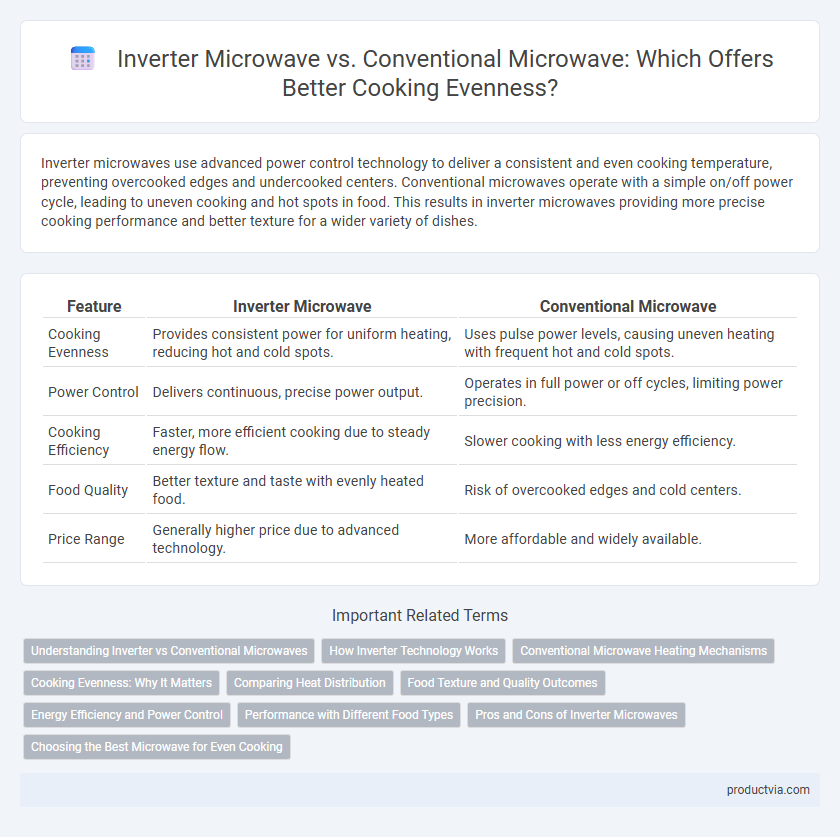Inverter microwaves use advanced power control technology to deliver a consistent and even cooking temperature, preventing overcooked edges and undercooked centers. Conventional microwaves operate with a simple on/off power cycle, leading to uneven cooking and hot spots in food. This results in inverter microwaves providing more precise cooking performance and better texture for a wider variety of dishes.
Table of Comparison
| Feature | Inverter Microwave | Conventional Microwave |
|---|---|---|
| Cooking Evenness | Provides consistent power for uniform heating, reducing hot and cold spots. | Uses pulse power levels, causing uneven heating with frequent hot and cold spots. |
| Power Control | Delivers continuous, precise power output. | Operates in full power or off cycles, limiting power precision. |
| Cooking Efficiency | Faster, more efficient cooking due to steady energy flow. | Slower cooking with less energy efficiency. |
| Food Quality | Better texture and taste with evenly heated food. | Risk of overcooked edges and cold centers. |
| Price Range | Generally higher price due to advanced technology. | More affordable and widely available. |
Understanding Inverter vs Conventional Microwaves
Inverter microwaves deliver consistent power levels by continuously adjusting the microwave energy, resulting in even cooking and better texture retention. Conventional microwaves cycle the magnetron on and off at full power, causing uneven heating and cold spots. Understanding the difference highlights how inverter technology enhances cooking precision compared to traditional microwave models.
How Inverter Technology Works
Inverter microwave technology uses a continuous, variable power supply to maintain a steady cooking temperature, ensuring food heats evenly without the fluctuations common in conventional microwaves that rely on on-off cycling. This precise power control allows for consistent energy distribution throughout the cooking process, reducing hot spots and improving overall food texture. The result is uniformly cooked dishes with better moisture retention compared to traditional microwaves.
Conventional Microwave Heating Mechanisms
Conventional microwaves use a magnetron to generate microwaves that agitate water molecules in food, creating heat through dielectric heating. This method often results in uneven cooking, as hot and cold spots develop due to the fixed power output and microwave distribution. The lack of power modulation and reliance on rotating turntables contribute to inconsistent temperature throughout the food.
Cooking Evenness: Why It Matters
Cooking evenness in inverter microwaves surpasses conventional models by delivering consistent power levels, ensuring food heats uniformly without cold spots or overcooked edges. This precise energy control prevents uneven textures and improves overall meal quality, particularly for delicate dishes that require gentle heating. Enhanced cooking evenness reduces the need for repeated reheating, conserving energy and saving time while maintaining optimal taste and safety.
Comparing Heat Distribution
Inverter microwaves provide consistent power delivery by adjusting the energy output, resulting in more even heat distribution and uniform cooking compared to conventional microwaves that operate at full power in cycles. Conventional microwaves tend to create hot spots and uneven cooking due to their on-off power cycles, which cause fluctuating heat intensity. The precise control of inverter technology ensures smoother temperature gradients within food, enhancing cooking evenness and reducing overcooked or undercooked areas.
Food Texture and Quality Outcomes
Inverter microwaves provide consistent power levels that enhance cooking evenness, resulting in improved food texture and moisture retention compared to conventional microwaves that operate with full power cycles and pauses. This precise power modulation reduces overcooking and cold spots, preserving the natural flavor and structural integrity of dishes. Consequently, meals prepared in inverter microwaves exhibit superior quality, with evenly heated interiors and a balanced, tender texture.
Energy Efficiency and Power Control
Inverter microwaves offer superior cooking evenness by delivering consistent power levels, unlike conventional microwaves that cycle their magnetrons on and off, causing uneven heat distribution. This continuous power control improves energy efficiency by reducing overcooking and energy waste, leading to faster and more uniform cooking. As a result, inverter technology optimizes both power usage and temperature accuracy, ensuring better cooking results with less electricity consumption.
Performance with Different Food Types
Inverter microwaves deliver consistent power levels that ensure uniform cooking across diverse food types, preventing hotspots and uneven heating common in conventional microwave models. Conventional microwaves cycle the magnetron on and off, leading to fluctuating energy distribution which can result in partially cooked areas, especially in dense or unevenly shaped foods. For delicate items like custards or frozen meals, inverter technology provides superior performance by maintaining steady temperatures, enhancing cooking precision and texture quality.
Pros and Cons of Inverter Microwaves
Inverter microwaves provide more consistent power output, resulting in even cooking and defrosting, which prevents overcooked edges and undercooked centers common in conventional microwaves. The precise control of energy levels in inverter technology allows for gradual heating, preserving food texture and flavor better than the typical on-off cycling power in conventional models. However, inverter microwaves tend to be more expensive and may require more maintenance due to their advanced electronics compared to the simpler design of conventional microwaves.
Choosing the Best Microwave for Even Cooking
Inverter microwaves use a consistent power supply to cook food evenly by adjusting the power output continuously, preventing overcooked edges and undercooked centers often seen in conventional microwaves. Conventional microwaves operate using a simple on-off cycling of full power, which can cause uneven heating due to fluctuations in microwave intensity. For optimal cooking evenness, selecting an inverter microwave ensures smoother temperature control and more uniform food preparation, making it the best choice for consistent results.
Inverter Microwave vs Conventional Microwave for Cooking Evenness Infographic

 productvia.com
productvia.com